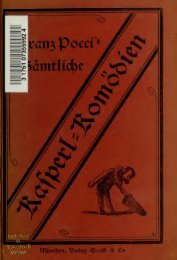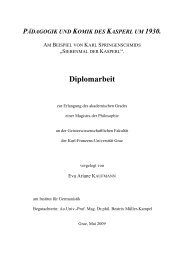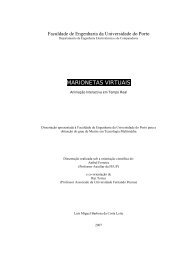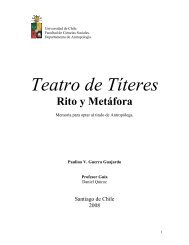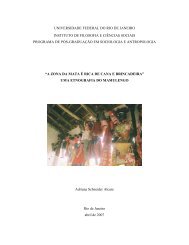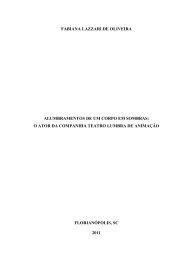ABSTRACT Title of Dissertation: THE PHENOMENOLOGY OF ...
ABSTRACT Title of Dissertation: THE PHENOMENOLOGY OF ...
ABSTRACT Title of Dissertation: THE PHENOMENOLOGY OF ...
Create successful ePaper yourself
Turn your PDF publications into a flip-book with our unique Google optimized e-Paper software.
program continued with a pair <strong>of</strong> negro entertainers-an Uncle Tom sort <strong>of</strong> gentleman with<br />
a banjo, and a decidely Topsyish gal with many lace petticoats. They were frankly low-<br />
brow, but, Barton assured everyone, ‘in the genuine puppet tradition.’” 216 Brown would<br />
later revise his objection for the second history, Small Wonder (1980), stating that “by<br />
present standards [they] would have been unthinkable.” 217 In both cases, Brown tolerates<br />
the minstrel puppets only because they are part <strong>of</strong> a historical tradition <strong>of</strong> performance.<br />
Brown’s objection to minstrel puppets may have discouraged the company from<br />
participating in such fare. Certainly, with Brown as their main playwright, the company<br />
would not have been likely to experiment with true minstrel shows or their descendents.<br />
Many <strong>of</strong> the plays the company did produce are founded on minstrel stereotypes<br />
and their descendents, but they adapt those stereotypes to more pr<strong>of</strong>ound themes. Mister<br />
Noah (1931) was a parody <strong>of</strong> the ancient Judeo/Christian tale <strong>of</strong> Noah and the great<br />
flood. 218 It included wisecracking pairs <strong>of</strong> animals, Albert Einstein as a stowaway, and a<br />
final destination <strong>of</strong> Ellis Island. It proved a very popular production on tour, on<br />
Broadway, and even in a private showing for the great scientist it satirized.<br />
The first incident in the play suggested a surprising connection between<br />
peripheral mythology, which developed around scripture, and racial hierarchies. Brown<br />
represented the great crowds <strong>of</strong> wicked human beings, suggested by Genesis 6:5, as “a<br />
216 Forman George Brown, Punch’s Progress (New York: MacMillan, 1936), 11.<br />
217<br />
Forman Brown, Small Wonder: The Story <strong>of</strong> the Yale Puppeteers (Metuchen, NJ: Scarecrow<br />
Press, 1980), 9.<br />
218 Since the three plays premiered within a two year period, I have chosen to follow the order in<br />
Brown’s published collection, The Pie-eyed Piper and Other Impertinent Puppet Plays (New York:<br />
Greenberg Press, 1933), rather than their historical chronology. I believe Brown intended his public to<br />
think <strong>of</strong> the plays in this order.<br />
166



